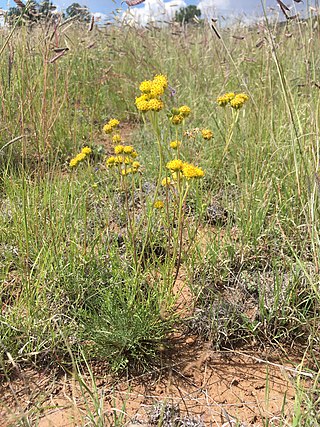
Gaillardia is a genus of flowering plants in the family Asteraceae, native to North and South America. It was named after Maître Gaillard de Charentonneau, an 18th-century French magistrate who was an enthusiastic botanist. The common name may refer to the resemblance of the inflorescence to the brightly patterned blankets made by Native Americans, or to the ability of wild taxa to blanket the ground with colonies. Many cultivars have been bred for ornamental use.

Gaillardia pulchella is a North American species of short-lived perennial or annual flowering plants in the sunflower family.

Romneya coulteri, the Coulter's Matilija poppy or California tree poppy, is a perennial species of flowering plant in the poppy family Papaveraceae. Native to southern California, USA, and Baja California, Mexico, it grows in dry canyons in chaparral and coastal sage scrub plant communities, sometimes in areas recently burned. It is a popular ornamental plant, kept for its large, showy flowers.

Gaillardia aristata is a North American species of flowering plant in the sunflower family, known by the common names common blanketflower and common gaillardia. This perennial wildflower is widespread across much of North America, from Yukon east to Québec and south as far as California, Arizona, Illinois, and Connecticut, although it may be naturalized rather than native in parts of that range. It is also naturalized in scattered locations in Europe, Australia, and South America.

Arida arizonica,, is an annual plant in the, known by the common names arid tansyaster, desert tansyaster, and Silver Lake daisy. It is native to the very arid deserts of northern Mexico and the southwestern United States, and usually looks straggly and not very attractive. But in years with very heavy rainfall, it fills out and becomes rounded and bush like.

Vitis arizonica is a North American species of wild grape. It is a deciduous vine.

Ratibida pinnata is a species of flowering plant in the family Asteraceae known by the common names pinnate prairie coneflower, gray-head coneflower, yellow coneflower, and prairie coneflower. It is native to the central and eastern United States and Ontario in Canada.
Wyethia arizonica, the Arizona mule's ears, is a plant species native to Arizona, Colorado, New Mexico and Utah. It grows in meadows in coniferous forests at elevations of 600–3,000 m (2,000–9,800 ft).

Gaillardia pinnatifida, the Hopi blanketflower or red dome blanketflower, is a perennial plant in the sunflower family (Asteraceae) found in northern Mexico and in the south-central and southwestern United States.
Helianthus laciniatus is a North American species of sunflower known by the common name alkali sunflower. It is found in the southwestern United States and north-central Mexico. It is fairly common in the Chihuahuan Desert.
Gaillardia amblyodon, the maroon blanketflower, is a species of flowering plant in the aster family. It has been found only in the state of Texas in the south-central United States.
Gaillardia coahuilensis, the bandanna daisy, is a North American species of flowering plant in the sunflower family. It is native to northwestern Mexico (Coahuila) and the southwestern United States.
Gaillardia multiceps, the onion blanketflower, is a North American species of flowering plant in the sunflower family. It is native to the southwestern United States.
Gaillardia parryi, or Parry's blanketflower, is a North American species of flowering plant in the sunflower family. It is native to the southwestern United States. Some of the populations are inside Grand Canyon National Park, others in Grand Staircase–Escalante National Monument.
Gaillardia spathulata, the western blanketflower, is a species of flowering plant in the sunflower family. It is native to the western United States.

Gaillardia suavis is a species of flowering plant in the sunflower family, common names pincushion daisy and perfumeballs. It is native to northern Mexico and the southern Great Plains of the United States.
Grindelia arizonica, the Arizona gumweed, is a North American species of flowering plants in the family Asteraceae. It is native to the southwestern United States and northern Mexico, in the States of Coahuila, Chihuahua, Arizona, New Mexico, Utah, Texas, and Colorado.
Hymenopappus flavescens, the collegeflower, is a North American species of flowering plant in the daisy family.

Hymenopappus mexicanus, the Mexican woollywhite, is a North American species of flowering plant in the daisy family. It grows in northern Mexico and the southwestern United States.
Tetraneuris argentea, the perkysue, is a North American species of plants in the sunflower family. It grows in the southwestern United States, primarily in Arizona and New Mexico with additional populations in Utah, Colorado, and the Texas Panhandle.









